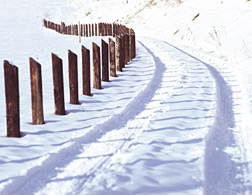It's the darkest month of the year, but the weather's not so bad.
Update, Dec. 21, 2010: Today is the shortest day of the year, and we're in the midst of the darkest month. Still, as Sophie Gilbert pointed out in 2008, the coldest months are yet to come. Her "Explainer" column is reprinted below.
Sunday marked the winter solstice—both the official start of winter and the shortest day of the year. But December is rarely as cold as January. Why isn't the month with the least sunlight also the one with the lowest temperatures?
Because water retains heat. Between 70 percent and 75 percent of the Earth's surface is covered in oceans, rivers, and lakes. (There's even more water vaporized in the air or stored in the ground.) During seasons of longer days and more sunlight, these geographical features are able to store up and retain heat over long periods of time, before emitting it as the days get shorter. A body of water is far more effective as a space heater than, say, a big field of rocks: The water holds on to five times as much heat per gram.

Large bodies of water thus serve as giant heat reservoirs, but they're not the only contributing factor to the seasonal lag in average temperatures. Properties of the Earth's atmosphere also contribute to the delayed onset of winter chills. Daily thermometer readings are determined, in part, by the balance between solar heat that's reflected by the planet surface (and bounced back into space) and solar heat that is absorbed into the climate system. This balance shifts as winter proceeds. At the beginning of the season, the temperature drops, which leads to an increased amount of snow covering the globe. This makes the Earth more reflective, with sunlight bouncing off the bright, white surfaces; more reflection exacerbates the cold weather and maintains the low temperatures. Gradually, as the days get longer, the snow melts, and the Earth's atmosphere begins to absorb more heat.
No comments:
Post a Comment